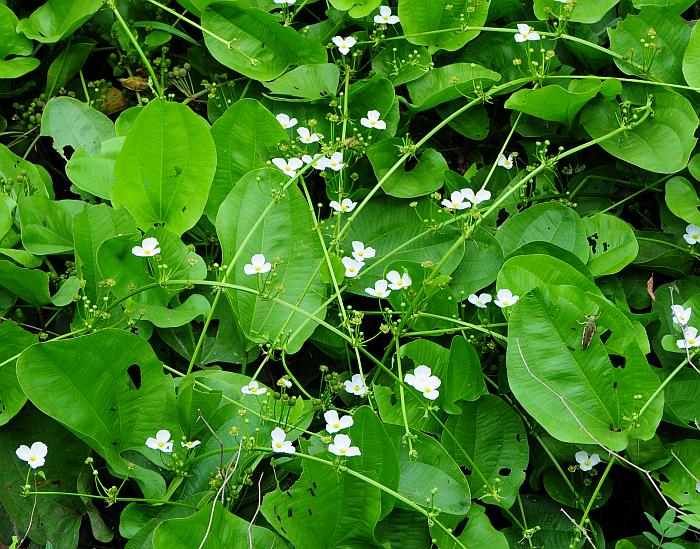Echinodorus cordifolius (L.) Griseb.
Creeping Burhead

Native
CC = 8
CW = -5
MOC = 17
© SRTurner
Echinodorus cordifolius (L.) Griseb.Creeping Burhead | |
 |
Native CC = 8 CW = -5 MOC = 17 |
© SRTurner |
|
Family - Alismataceae Habit - Perennial, creeping, emergent aquatic forb. Stems - Aerial stems absent. Leaves - Basal, with long petioles. Leaf blades 10-60 cm long, broadly ovate with cordate bases, the tissue with transparent lines mostly more than 1 mm apart and less than 1 mm long (hold leaf up to light). Venation with palmate main veins arching from the base of the midrib and rejoining near the apex, these connected by a series of parallel, angled veins.
Inflorescence - Arching, prostrate at maturity, the nodes sometimes rooting and producing plantlets from bulbils, with several to many whorls of 5-15 flowers, unbranched. Inflorescence bracts 3, 10-25 mm long, linear-lanceolate, acuminate. Additional smaller bractlets also present.
Flowers - Flowers perfect. Sepals 5-7 mm long, ovate to orbicular, persistent, reflexed in fruit. Petals 6-12 mm long, white, obovate. Stamens many, the anthers 1.0-1.5 mm long, the filament attached toward the middle of the anther. Pistils many, forming a dense headlike cluster on the expanded receptacle.
Fruits - Borne in orbicular clusters. Fruits 1.8-2.5 mm long, brown, with 6-8 curved ribs, the beak 0.2-0.5 mm long, attached obliquely.
Flowering - July - September. Habitat - Emergent aquatics in mud along margins of ponds, sloughs, swamps, marshes, ditches, often in shallow water. Origin - Native to the U.S. Lookalikes - None. Other info. - This plant is widely scattered, and not all that common in the state except in the Bootheel region. Its wider distribution includes much of the southeastern continental U.S., and is particularly concentrated in a wide band running along the Mississippi River southward from Missouri to the Gulf Coast. The plant is easily recognized by its aquatic habitat, interesting leaves with their distinctive venation, and arching or prostrate inflorescences. It is unique among the Missouri Alismataceae family members in having nodes with several flowers all pointing in the same direction. There is some evidence that this species may hybridize with the closely related E. berteroi. Photographs taken at Otter Slough Conservation Area, Stoddard County, MO, 7-31-2015 and 9-10-2019, and Duck Creek Conservation Area, 8-17-2021 (SRTurner). |